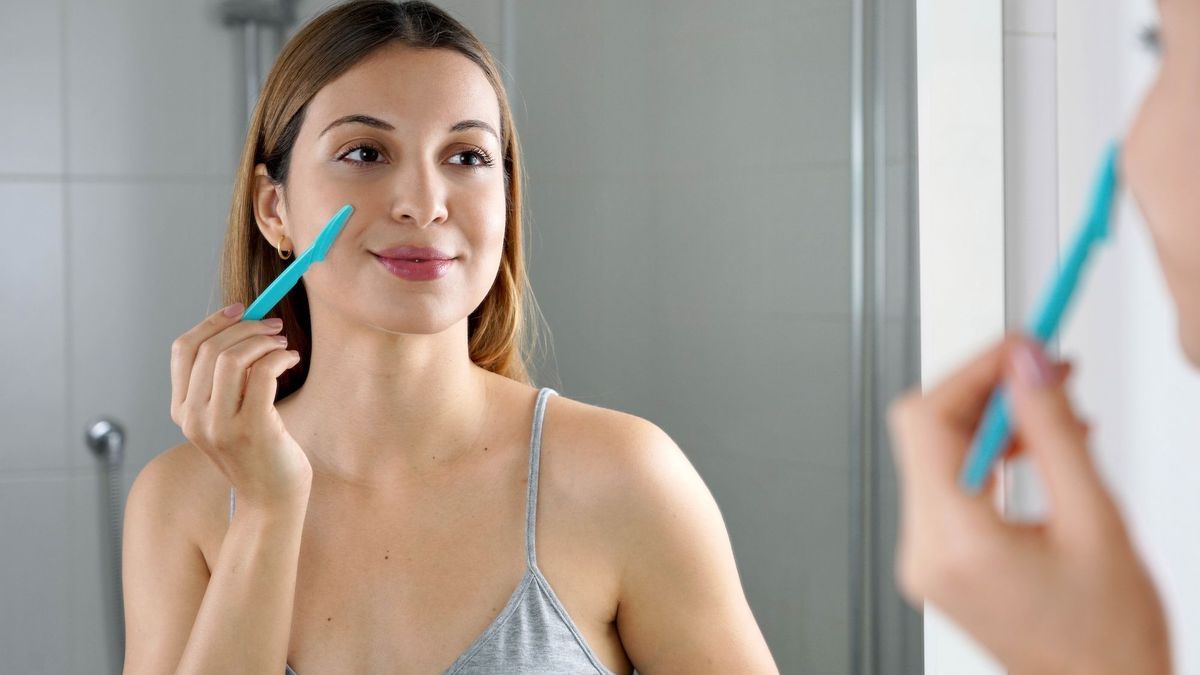
Popular with celebrities and adopted by 18-30 year olds, dermaplaning is far from being unanimously approved by dermatologists. And for good reason, this beauty trend would be very aggressive for the skin in the long term. So what is dermaplaning? And what are the risks associated with this method? An update with Dr Caroline Pouget, dermatologist and founder of the Renécia dermato-aesthetic clinic in Paris.
Shaving your face with razor blades (whether for a woman or a man) in order to exfoliate it is a new popular trend on social networks. Riding on the buzz, specialized sites even offer razor kits adapted to the face. Tools that can be misused and damage the epidermis. A controversial practice, called dermaplaning, which worries dermatologists.
What is dermaplaning?
It is good to first point out that dermaplaning is not an exfoliating treatment practiced in dermatology offices, but rather a treatment offered in certain beauty institutes. It consists of removing the first superficial layer of the skin, using a surgical scalpel whose action is similar to a razor. The objective of this beauty technique? Eliminate dead cells by shaving the face, and therefore its hair. Dermaplaning, however, is not presented as a first-line hair removal method.
What would be the benefits of dermaplaning for the face?
According to his aficionados (mostly women), dermaplaning has many advantages:
- Give the face a new glow;
- Reduce pore size;
- Regenerate cells;
- Smooth wrinkles;
- Make the skin softer;
- Make it easier to apply and hold makeup;
- Promote the absorption of creams and treatments;
However, for some dermatologists, the effects of this exfoliating treatment via facial shaving would be short-lived. “ There can be an immediate wow effect linked to shaving, which, despite everything, is no match for the consequences that this technique can have on the skin. », warns Dr Caroline Pouget. « In the long term, there can be many side effects on the face », she adds.
Dermaplaning treatment: is it dangerous for the skin?
Despite potentially tempting results, dermaplaning is not without its risks. Passing the steel blade during the session can, in fact, trigger a folliculitis reaction on acne-prone or hypersensitive skin. Without sparing normal skin, however. As a result, every skin type is affected, both in women and men. “ It is a treatment which remains traumatic for the epidermis », underlines the dermatologist. “ This is not an exfoliation method, nor a hair removal technique that I recommend » she adds.
According to the expert, founder of the Renécia dermato-aesthetic clinic, the risks associated with dermaplaning are as follows:
- A paradoxical regrowth of facial hair, i.e. the appearance of coarser hair;
- Acne breakouts;
- The appearance of folliculitis (skin condition);
- An increase in hypersensitivity of the skin;
- Secondary hyperpigmentation;
- Micro-cuts if the gesture is poorly executed;
The list of dangers above being significant for the skin, it is advisable to favor exfoliation techniques that are more traditional and less abrasive than a steel scalpel blade. The most important thing is to obtain satisfactory results without putting yourself in danger with an aggressive tool. “ It is safer, for example, to opt for a peel at your dermatologist or a traditional facial treatment at a beauty salon. », Recommends Dr Caroline Pouget. More respectful care, which does not modify the protective function of the epidermis. As for routine, choose products adapted to your skin type.
Does hair grow back thicker after a dermaplaning session?
The answer is yes. As a skin expert, Caroline Pouget does not recommend shaving the fuzz. “ If practiced regularly, dermaplaning will stimulate paradoxical hair regrowth. » alerts the expert. In fact, over time, the down gives way to thicker and coarser hairs on the skin. The areas of the chin and upper lip are more prone to this so-called paradoxical regrowth. Not to mention that ingrown hairs can form under the epidermis. Because of these inconveniences, some women regretted the experience. Whether with a scalpel or a razor, hair removal using these tools should therefore be avoided.
What precautions should you take after a dermaplanning session?
Dermaplaning eliminates hair and dead cells, of course, but also alters the protective function of the skin. While the latter may appear more radiant and soft, it is also more vulnerable. After a session, it is important to apply healing treatments and an anti-bacterial product, as well as a sunscreen. A significant boost to help the skin protect itself from UV rays and pollution. As the skin absorbs more active ingredients, you should be careful about the products you use.
Can you do dermaplaning yourself?
As the risk of cuts is high, it is strongly recommended not to carry out dermaplaning at home, with a traditional razor. Even though online courses and advertisements showing “how to shave your face” abound on social networks, it is strongly recommended to go to a professional. Not only is he used to the gesture, but he also uses more appropriate equipment, namely a unique scalpel blade. Properly performed, in-office dermaplaning is generally painless and lasts approximately 30 to 45 minutes. Before the treatment, the skin is cleaned and disinfected to limit the spread of bacteria.
However, remember that dermaplaning is a beauty trend that is not recommended by dermatologists. Better to turn to gentler treatments and adopt a healthy lifestyle to gain radiance. Stopping smoking, eating a diet rich in fruits and vegetables and moderate exposure to the sun are already the first steps to taking care of your skin.
